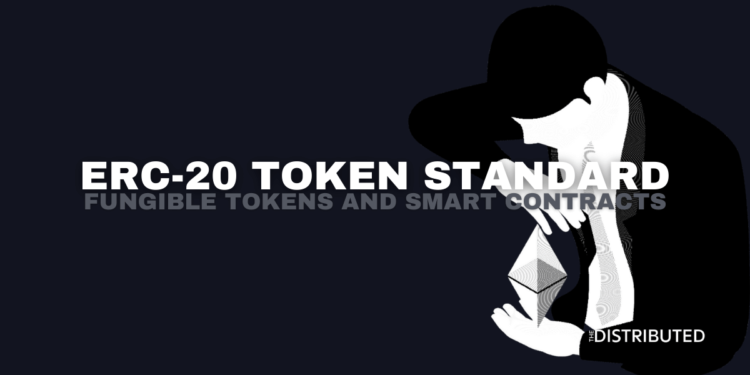WARNING: unbalanced footnote start tag short code found.
If this warning is irrelevant, please disable the syntax validation feature in the dashboard under General settings > Footnote start and end short codes > Check for balanced shortcodes.
Unbalanced start tag short code found before:
“Ethereum – ERC-20 Token Standard For a token to be compliant with the ERC-20 standards, it must be able to perform 6 vital functions;”
Not all cryptocurrencies have their own blockchain. Rather there are some that run on top of a blockchain, these are called tokens. The most popular and well-known example of this is Ethereum, with over 500,000 tokens running on top of the Ethereum blockchain.
Ethereum Request for Comment (ERC-20) is the token standard used for Ethereum Smart Contracts. The 500,000 tokens running on top of the Ethereum blockchain are essentially just smart contracts that follow a few common rules.
What Is Ethereum?
Ethereum is a decentralized network of computers that serves 2 primary functions; record transactions on a blockchain and produce smart contracts through a virtual machine.
These 2 primary functions facilitate the support of decentralized apps or dApps. dApps are built upon the Ethereum blockchain and use its technology, depending on the purpose of the dApp, they may create and/or utilize ERC-20 token. These tokens can represent anything, from a stablecoin to shares in a company and even proof of ownership. ((CoinTelegraph – ERC-20 Tokens, Explained))
What Is A Token?
A token represents the fungible assets that are native to a blockchain’s ecosystem. A token is a virtual currency that is designed with utility in mind, providing access to limited functions in a larger blockchain ecosystem. ((CoinMarketCap – Token))
Tokens are often mixed around with cryptocurrencies and altcoins, although both altcoins and tokens falling under the cryptocurrency category. They are not like for like.
Tokens are held in smart contracts, which act as a database that records both transactions and balances of tokens in a specified account. It is within the contract that the rules and functions of the token are mapped out.
What’s An ERC-20 Token?
The ERC-20 token standard was introduced to implement an API for fungible tokens within a smart contract. Through its API all tokens on the Ethereum network can communicate with each other. Fungible tokens are like for like, in both type and value. ((Ethereum – ERC-20 Token Standard))
Ethereum developers saw that as more and more tokens were created on the Ethereum blockchain, it became harder for them to interact with each other. ERC-20 was proposed in 2015 as a standard to help facilitate the creation of tokens. It can be compared to a set of guidelines in a token must follow to become a token on Ethereum.
This compliance between tokens is necessary as it ensures compatibility between the many different tokens issued on Ethereum. Many token developers have complied with the ERC-20 standard such as; Tether ($USDT), Shiba Inu ($SHIB), and Polygon ($MATIC).
Why Are ERC-20 Fees So High?
When an ERC-20 token is transferred, you must pay a gas fee. The gas fee is paid in Ether, the native cryptocurrency to Ethereum’s blockchain.
Due to the huge amount of contracts on top of the Ethereum blockchain network congestion raises fees as miners are constantly competing to be the ones to validate the block. The greater the demand for Ethereum, the higher gas fees will keep rising. This is one of the main reasons Ethereum is slowly switching over to a Proof-of-Stake consensus rather than Proof-of-Work.
What Is The ERC-20 Standard?
If a Smart Contract implements the following methods and events it can be called an ERC-20 Token Contract and, once deployed, it will be responsible to keep track of the created tokens on Ethereum.((Ethereum – ERC-20 Token Standard
For a token to be compliant with the ERC-20 standards, it must be able to perform 6 vital functions; ((EIP-20: Token Standard – Specification))
- totalSupply: Returns the total token supply.
- balanceOf: Returns the account balance of the owners account.
- transfer: Executes a transfer of a specific amount of tokens to a specified address.
- transferFrom: Executes a transfer of a specific amount of tokens from a specified address.
- approve: Allows a spender to withdraw a specified amount of tokens, from a specified account.
- allowance: Returns a set number of tokens a spender can still withdraw from a specified account.
There are also 3 optional functions, that can improve usability;
- name: Returns the name of the token, for example; MyToken.
- symbol: Returns the symbol of the token, for example; MYT.
- decimals: Returns the number of decimals the token uses, for example; MYT trades at $0.0004 would mean MyToken has a decimal value of 4.
These standard functions will set off 2 events within the ERC-20 token. The events are ‘transfer‘ and ‘approval‘. A transfer is when tokens are sent to a specified address and approval is when a token is confirmed as transferred to the address.



